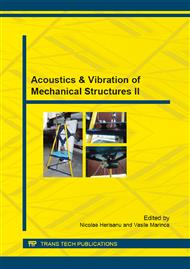[1]
S. Şt. Biriş, M. Manea, E. Maican, N. Ungureanu, L. Toma, Studies regarding the use of Finite Elements Method for the working process modelling of the oil presses, Proceeding of the 37th International Symposium Actual Tasks on Agricultural Engineering, Croaţia, Opatija, 2009, pp.485-496.
Google Scholar
[2]
S. Şt. Biriş, M. Manea, G. Paraschiv, V. Vlăduţ, S. Bungescu, Power calculus elements for oil presses, Proceeding of the 37th International Symposium Actual Tasks on Agricultural Engineering, Croaţia, Opatija, 2009, pp.475-484.
Google Scholar
[3]
J. Chanona-Pérez, R. Quevedo, A.R. Jiménez Aparicio, C. Gumeta Chávez, J.A. Mendoza Pérez, G.C. Domínguez, L. Alamilla-Beltrán, G.F. Gutiérrez-López, Image Processing Methods and Fractal Analysis for Quantitative Evaluation of Size, Shape, Structure and Microstructure in Food Materials, Food Engineering: Integrated Approaches, Food Engineering series 2008, pp.277-286.
DOI: 10.1007/978-0-387-75430-7_16
Google Scholar
[4]
Al. Dihoru, Gh. Dihoru, Plants used in humans and animals digestion, Ed. ARS DOCENTI, Bucharest (2008).
Google Scholar
[5]
G. ElMasry, S. Cubero, E. Moltó, J. Blasco, In-line sorting of irregular potatoes by using automated computer-based machine vision system, Journal of Food Engineering 112 (2012), p.60–68.
DOI: 10.1016/j.jfoodeng.2012.03.027
Google Scholar
[6]
P.R. Johnston, A. Swanson, Correlation between the results of different instruments used to determine the particle size distribution in AC fine test dust. Powder Technology 32 (1): 1982, p.119–124.
DOI: 10.1016/0032-5910(82)85012-2
Google Scholar
[7]
M. Panasiewicz, P. Sobczak, J. Mazur, K. Zawis´lak, D. Andrejko, The technique and analysis of the process of separation and cleaning grain materials, Journal of Food Engineering 109 (2012), p.603–608.
DOI: 10.1016/j.jfoodeng.2011.10.010
Google Scholar
[8]
L.A. Rovinsky, Application of separation theory to hydrocyclone design. Journal of Food Engineering 26 (2): 1995, p.131–146.
DOI: 10.1016/0260-8774(94)00019-6
Google Scholar
[9]
E. Salemi, U. Tessari, N.C.M. Mastrocicco, Improved gravitational grain size separation method. Applied Clay Science 48 (4): 2010, p.612–614.
DOI: 10.1016/j.clay.2010.03.014
Google Scholar
[10]
V. Vladut, I. Pirna, C. Florea, C. Popescu, Gh. Bratucu, O. Kabas, D. Paunescu, Influence of the vibration amplitude on the quality of shredded medicinal vegetal material subjected to sorting, Proceeding of the 42nd International Symposium Actual Tasks on Agricultural Engineering, Croaţia, Opatija, 2014, pp.273-282.
Google Scholar
[11]
X. Yang, C. Bern, C.R. Hurburgh, Airflow resistance of cleanings removes from corn. TRANSACTIONS OF THE ASAE, vol. 33(4): 1990, pp.1299-1302, (1990).
DOI: 10.13031/2013.31472
Google Scholar


